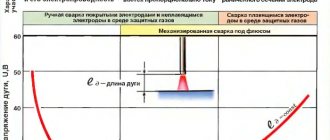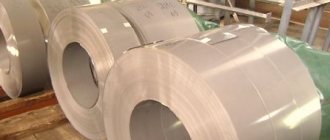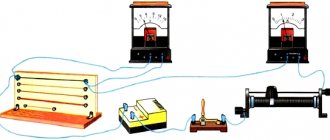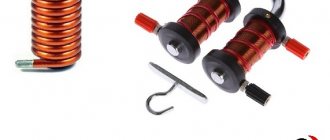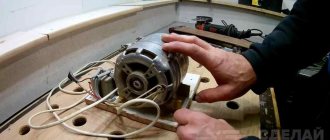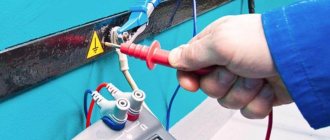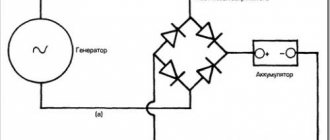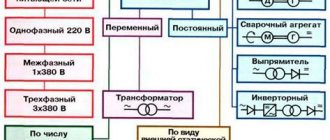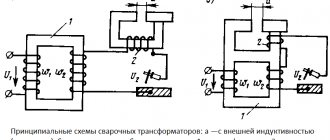Due to the fact that there are two types of electrical resistances -
In connection with the electromagnetic phenomena that arise in conductors when alternating current passes through them, two physical phenomena that are important for their electrical properties arise.
The last two phenomena make it ineffective to use conductors with a radius greater than the characteristic depth of penetration of electric current into the conductor. Effective conductor diameter (2RBhar): 50Hz -7 Ohm. Using microohmmeters, you can determine the quality of electrical contacts, the resistance of electrical busbars, windings of transformers, electric motors and generators, the presence of defects and foreign metal in ingots (for example, the resistance of a pure gold ingot is half that of a gold-plated tungsten ingot).
To calculate the length of the wire, its diameter and the required electrical resistance, it is necessary to know the resistivity of the conductors ρ.
In the international system of units, resistivity ρ is expressed by the formula:
It means: the electrical resistance of 1 meter of wire (in Ohms), with a cross-section of 1 mm 2, at a temperature of 20 degrees Celsius.
Conductor resistivity table
| Conductor material | Specific resistance ρ in |
| Silver Copper Gold Brass Aluminum Sodium Iridium Tungsten Zinc Molybdenum Nickel Bronze Iron Steel Tin Lead Nickelin (an alloy of copper, nickel and zinc) Manganin (an alloy of copper, nickel and manganese) Constantan (an alloy of copper, nickel and aluminum) Titanium Mercury Nichrome (an alloy of nickel, chromium, iron and manganese) Fechral Bismuth Chromal | 0,015 0,0175 0,023 0,025. 0,108 0,028 0,047 0,0474 0,05 0,054 0,059 0,087 0,095. 0,1 0,1 0,103. 0,137 0,12 0,22 0,42 0,43. 0,51 0,5 0,6 0,94 1,05. 1,4 1,15. 1,35 1,2 1,3. 1,5 |
The table shows that an iron wire with a length of 1 m and a cross-section of 1 mm 2 has a resistance of 0.13 Ohm. To get 1 Ohm of resistance you need to take 7.7 m of such wire. Silver has the lowest resistivity. 1 Ohm of resistance can be obtained by taking 62.5 m of silver wire with a cross section of 1 mm 2. Silver is the best conductor, but the cost of silver excludes the possibility of its mass use. After silver in the table comes copper: 1 m of copper wire with a cross section of 1 mm2 has a resistance of 0.0175 Ohm. To get a resistance of 1 ohm, you need to take 57 m of such wire.
Chemically pure copper, obtained by refining, has found widespread use in electrical engineering for the manufacture of wires, cables, windings of electrical machines and devices. Aluminum and iron are also widely used as conductors.
The conductor resistance can be determined by the formula:
where r is the conductor resistance in ohms; ρ – conductor resistivity; l – conductor length in m; S – conductor cross-section in mm2.
Example 1. Determine the resistance of 200 m of iron wire with a cross section of 5 mm 2.
Example 2. Calculate the resistance of 2 km of aluminum wire with a cross section of 2.5 mm 2.
From the resistance formula you can easily determine the length, resistivity and cross-section of the conductor.
Example 3. For a radio receiver, it is necessary to wind a 30 Ohm resistance from nickel wire with a cross section of 0.21 mm 2. Determine the required wire length.
Example 4. Determine the cross-section of 20 m of nichrome wire if its resistance is 25 Ohms.
Example 5. A wire with a cross section of 0.5 mm 2 and a length of 40 m has a resistance of 16 Ohms. Determine the wire material.
The material of the conductor characterizes its resistivity.
Based on the resistivity table, we find that lead has this resistance.
It was stated above that the resistance of conductors depends on temperature. Let's do the following experiment. Let's wind several meters of thin metal wire in the form of a spiral and connect this spiral to the battery circuit. To measure current, we connect an ammeter to the circuit. When the coil is heated in the burner flame, you will notice that the ammeter readings will decrease. This shows that the resistance of a metal wire increases with heating.
For some metals, when heated by 100°, the resistance increases by 40–50%. There are alloys that change their resistance slightly with heating. Some special alloys show virtually no change in resistance when temperature changes. The resistance of metal conductors increases with increasing temperature, while the resistance of electrolytes (liquid conductors), coal and some solids, on the contrary, decreases.
The ability of metals to change their resistance with changes in temperature is used to construct resistance thermometers. This thermometer is a platinum wire wound on a mica frame. By placing a thermometer, for example, in a furnace and measuring the resistance of the platinum wire before and after heating, the temperature in the furnace can be determined.
If at temperature t the resistance of the conductor is equal to r, and at temperature t is equal to rt, then the temperature coefficient of resistance
Note. Calculation using this formula can only be done in a certain temperature range (up to approximately 200°C).
We present the values of the temperature coefficient of resistance α for some metals (Table 2).
Specific resistance and electrical conductivity of a substance.
Electrical resistivity is a value that characterizes the electrical conductivity of a substance, or more precisely, the ability of this substance to prevent the passage of electric current through it, in a word, determining how easily any material passes an electric charge. The SI unit of resistivity is Ohm m.
Specific conductivity is a value inversely proportional to specific resistance, which determines the ability of a substance to conduct electric current. The unit of measurement is siemens per meter (S/m) or Ohm-¹·m-¹.
Formula for the resistance of cylindrical conductors
For a homogeneous cylindrical conductor.
Let us select in the conductor an elementary cylindrical volume dV with generatrices dl parallel to the current density vector at a given point (Fig. 17.2). A current of force flows through the cross section dS of the cylinder. The voltage applied to the cylinder is equal to , where E is the field strength at a given location. Cylinder resistance. Substituting these values into equation (17.5), we obtain
Charge carriers at each point move in the direction of the vector. Therefore, the directions of the vectors coincide. Thus, one can write
The reciprocal of resistance is called conductivity
Resistance of metal conductors.
The resistance of metal conductors increases with increasing temperature and decreases with decreasing temperature. Each temperature value corresponds to a certain conductor resistance value
2.7.
Ohm's law.
Current is directly proportional to voltage and inversely proportional to resistance.
Ohm's law in differential form.
Based on Ohm's law (7.6.1), we have:
And we know that or . From here we can write
this is a representation of Ohm's law in differential form .
Classical theory of electrical conductivity of metals.
Drude suggested that conduction electrons in a metal behave like molecules of an ideal gas. In the intervals between collisions they move completely freely, covering a certain distance on average. True, unlike gas molecules, the range of which is determined by the collisions of molecules with each other, electrons collide primarily not with each other, but with ions that form the crystal lattice of the metal. These collisions lead to the establishment of thermal equilibrium between the electron gas and the crystal lattice. Assuming that the results of the kinetic theory of gases can be extended to electron gas, the average speed of thermal motion of electrons can be estimated using the formula. For room temperature (300K) calculation using this formula leads to the following value: . When the field is turned on, the chaotic thermal movement occurring at a speed is superimposed on the ordered movement of electrons with a certain average speed. The magnitude of this speed is easy to estimate based on the formula relating the current density j with the number n of carriers per unit volume, their charge e and average speed:
The maximum current density allowed by technical standards for copper wires is about
Thus, even at high current densities, the average speed of ordered motion of charges is several times less than the average speed of thermal motion.
Work of electric current.
Joule-Lenz law.
When an electric current passes through a conductor, the amount of heat generated in the conductor is directly proportional to the square of the current, the resistance of the conductor, and the time during which the electric current flowed through the conductor.
2.8.
Magnetic interaction.
Magnetic interaction is the interaction of ordering moving electric charges.
A magnetic field.
A magnetic field is a special type of matter through which interaction occurs between moving electrically charged particles.
Lorentz force and Ampere force.
The Lorentz force is a force acting from a magnetic field on a positive charge moving at speed (here – the speed of the ordered movement of positive charge carriers). Lorentz force modulus:
The Ampere force is the force with which a magnetic field acts on a current-carrying conductor.
The ampere force module is equal to the product of the current strength in the conductor by the magnitude of the magnetic induction vector, the length of the conductor and the sine of the angle between the magnetic induction vector and the direction of the current in the conductor.
The Ampere force is maximum if the magnetic induction vector is perpendicular to the conductor.
If the magnetic induction vector is parallel to the conductor, then the magnetic field has no effect on the current-carrying conductor, i.e. Ampere's force is zero.
The direction of Ampere's force is determined by the left-hand rule.
Temperature coefficient values for some metals
| Metal | α | ||
| Silver Copper Iron Tungsten Platinum | 0,0035 0,0040 0,0066 0,0045 0,0032 | Mercury Nikelin Constantan Nichrome Manganin | 0,0090 0,0003 0,000005 0,00016 0,00005 |
From the formula for the temperature coefficient of resistance we determine rt:
Example 6. Determine the resistance of an iron wire heated to 200°C, if its resistance at 0°C was 100 Ohms.
Example 7. A resistance thermometer made of platinum wire in a room with a temperature of 15°C had a resistance of 20 ohms. The thermometer was placed in the oven and after some time its resistance was measured. It turned out to be equal to 29.6 Ohms. Determine the temperature in the oven.
Electrical conductivity
So far, we have considered the resistance of a conductor as the obstacle that the conductor provides to the electric current. But still, current flows through the conductor. Therefore, in addition to resistance (obstacle), the conductor also has the ability to conduct electric current, that is, conductivity.
The more resistance a conductor has, the less conductivity it has, the worse it conducts electric current, and, conversely, the lower the resistance of a conductor, the more conductivity it has, the easier it is for current to pass through the conductor. Therefore, the resistance and conductivity of a conductor are reciprocal quantities.
Electric current - conductivity
Electric conduction current in metals represents the ordered movement of electrons. This movement is superimposed on their chaotic thermal movement and arises under the influence of the electric field created in the metal. Consequently, in order for the electrons of the metal to begin to move orderly under the influence of an external electric field, they must increase their energy. At normal circuit voltages, electrons take on very little energy. [1]
Electrical conduction current in metals represents the ordered movement of electrons. This movement is superimposed on their chaotic thermal movement and occurs under the influence of the electric field created in the metal. Consequently, in order for the electrons of the metal to begin to move orderly under the influence of an external electric field, they must increase their energy. At ordinary voltages, electrons take on very little energy. In the event that there are close energy levels not occupied by other electrons, electrons transition to these free levels and an electric current arises in the direction of the external electric field. [2]
Electric conduction current is the ordered movement i, in matter or vacuum, of free charged particles, current carriers. [3]
Electric conduction current is the ordered movement in matter or vacuum of free charged particles of current carriers. Examples of such currents include electric currents in metals, electrolytes, ionized gases, plasma, semiconductors, beams of electrons or ions in a vacuum. [4]
Electric conduction current is usually called the phenomenon of directed movement of free electric charge carriers in a substance or in emptiness. [5]
Electric conduction current is the phenomenon of directed movement of free electric charge carriers in a substance or vacuum. [6]
Electric conduction current is usually called the phenomenon of directed movement of free electric charge carriers in a substance or in emptiness. [7]
The phenomenon of electric conduction current is of great practical importance. The most important energy transformations are associated with it: obtaining electrical energy from other types of energy and converting it back; transmission of electrical energy over a distance. [8]
The phenomenon of electric conduction current is of great practical importance. [10]
This is an electric conduction current called leakage current. [eleven]
For the electric conduction current to remain constant, it is necessary that the electric field strength at all points of the conductor through which this current flows remains unchanged. Therefore, charges should not: accumulate or decrease anywhere in a conductor through which a direct electric current flows. [12]
For the constancy of the electric conduction current, it is necessary that the electric field strength at all points of the conductor to which this current flows remains unchanged. [13]
Let's consider another type of electric conduction current, called electric transfer current, which is understood as the phenomenon of transfer of electric charges by charged particles or bodies moving in free space. The transfer current differs from the conduction current in conductors in that its density cannot be represented by the relation J yE, where the specific conductivity y is a certain value characterizing the medium conducting the current. The acceleration of such a particle is proportional to the field strength. Accordingly, its movement in free space will be uniformly accelerated, since there is no resistance from the medium. [14]
Why can a conductive electric current pass through conductors, but not through ideal dielectrics? [15]
High conductivity materials
The most widespread materials of high conductivity include copper and aluminum (Superconducting materials, which have a typical resistance of 10-20 times lower than ordinary conductive materials (metals), are discussed in the section Superconductivity).
The advantages of copper, which ensure its widespread use as a conductor material, are as follows:
- low resistivity;
- sufficiently high mechanical strength;
- corrosion resistance is satisfactory in most applications;
- good workability: copper is rolled into sheets, strips and drawn into wire, the thickness of which can be increased to thousandths of a millimeter;
- relative ease of soldering and welding.
Copper is most often obtained by processing sulfide ores. After a series of ore smelting and roasting with intense blasting, copper intended for electrical purposes must undergo a process of electrolytic purification.
Copper grades M1 and M0 are most often used as conductor material. M1 grade copper contains 99.9% Cu, and in the total amount of impurities (0.1%) oxygen should be no more than 0.08%. The presence of oxygen in copper worsens its mechanical properties. The best mechanical properties are found in M0 grade copper, which contains no more than 0.05% impurities, including no more than 0.02% oxygen.
Copper is a relatively expensive and scarce material, so it is increasingly being replaced by other metals, especially aluminum.
In some cases, alloys of copper with tin, silicon, phosphorus, beryllium, chromium, magnesium, and cadmium are used. Such alloys, called bronzes, with the correct composition, have significantly higher mechanical properties than pure copper.
Aluminum
Aluminum is the second most important conductor material after copper. This is the most important representative of the so-called light metals: the density of cast aluminum is about 2.6, and rolled aluminum is 2.7 Mg/m3. Thus, aluminum is approximately 3.5 times lighter than copper. The temperature coefficient of expansion, specific heat capacity and heat of fusion of aluminum are greater than those of copper. Due to the high values of specific heat capacity and heat of fusion, heating aluminum to the melting point and transferring it to a molten state requires more heat than heating and melting the same amount of copper, although the melting point of aluminum is lower than that of copper.
Aluminum has lower properties compared to copper - both mechanical and electrical. With the same cross-section and length, the electrical resistance of an aluminum wire is 1.63 times greater than that of a copper wire. It is very important that aluminum is less scarce than copper.
For electrical purposes, aluminum containing no more than 0.5% impurities, grade A1, is used. Even purer AB00 grade aluminum (no more than 0.03% impurities) is used for the manufacture of aluminum foil, electrodes and housings of electrolytic capacitors. Aluminum of the highest purity AB0000 has an impurity content of no more than 0.004%. Additives of Ni, Si, Zn or Fe at a content of 0.5% reduce the γ of annealed aluminum by no more than 2-3%. A more noticeable effect is exerted by Cu, Ag and Mg impurities, which, at the same mass content, reduce γ aluminum by 5-10%. Ti and Mn greatly reduce the electrical conductivity of aluminum.
Aluminum oxidizes very actively and becomes covered with a thin oxide film with high electrical resistance. This film protects the metal from further corrosion.
Aluminum alloys have increased mechanical strength. An example of such an alloy is Aldrey , containing 0.3-0.5% Mg, 0.4-0.7% Si and 0.2-0.3% Fe. In aldrey, the Mg2Si compound is formed, which imparts high mechanical properties to the alloy.
Iron and steel
Iron (steel), as the cheapest and most accessible metal, which also has high mechanical strength, is of great interest for use as a conductor material. However, even pure iron has a significantly higher resistivity compared to copper and aluminum; ρ steel, i.e. iron mixed with carbon and other elements is even higher. Ordinary steel has low corrosion resistance: even at normal temperatures, especially in conditions of high humidity, it quickly rusts; As the temperature rises, the corrosion rate increases sharply. Therefore, the surface of steel wires must be protected by a layer of more resistant material. Zinc coating is usually used for this purpose.
In some cases, to reduce the consumption of non-ferrous metals, the so-called bimetal . It is steel coated on the outside with a layer of copper, with both metals connected to each other firmly and continuously.
Sodium
Sodium metal is a very promising conductor material. Sodium can be obtained by electrolysis of molten sodium chloride NaCl in virtually unlimited quantities. From a comparison of the properties of sodium with the properties of other conductor metals, it is clear that the resistivity of sodium is approximately 2.8 times greater than ρ of copper and 1.7 times greater than ρ of aluminum, but due to the extremely low density of sodium (its density is almost 9 times less than the density of copper), a wire made of sodium for a given conductivity per unit length should be significantly lighter than a wire made of any other metal. However, sodium is extremely active chemically (it oxidizes intensely in air and reacts violently with water), which is why the sodium wire must be protected with a sealing sheath. The sheath must give the wire the necessary mechanical strength, since sodium is very soft and has a low tensile strength during deformation.
2.1.1. Physical nature of electrical conductivity of metals
Metals have a crystalline structure: at the nodes of the crystal lattice there are positively charged ions surrounded by itinerant electrons (electron gas).
Modern ideas about the electronic structure of metals, the distribution of electrons over energy states, their interaction with other elementary particles and the crystal lattice are given by quantum theory, the foundations of which were developed by the Soviet scientist Ya.I. Frenkel and the German physicist A. Sommerfeld.
Read also: Recommend an electric grill for home
Free electrons move chaotically throughout the crystal with an average thermal speed u = 10 5 m/s. In an electric field of strength E, electrons receive an additional speed of ordered movement v - drift speed, due to which an electric current arises. The current density depends on the drift speed, the electron charge e and the concentration of free electrons n.
The drift speed in real conditions is significantly less than the speed of thermal motion of electrons vu. So, in the copper industry
in a water carrier at a current density j = 1 A/mm 2 the drift speed is v = 1. 10 -4 m/s.
During the time τ between collisions with nodes of the crystal lattice at the mean free path l, electrons moving with acceleration
rhenium a = e E , acquire drift speed: me
Equating the analytical expression of Ohm's law (1.1) with expression (2.1) taking into account (2.2), we obtain the formula for specific conductivity
Let's express the product me. and through the concentration of free electrons, using quantum statistics based on the Pauli principle, according to which there can be only one electron in each energy state, and no more than two (with antiparallel spins) in each energy level. Then, at absolute zero temperature (T = 0 K), half of the total number of free electrons in the crystal (n/2) will occupy the lowest energy levels.
In quantum theory, the probability of electrons filling energy states with level energy E is determined by the Fermi function
where E F is the Fermi energy, i.e. the maximum energy that an electron in a metal can have at absolute zero temperature.
From formula (2.4) it follows that when E = E F, the probability of filling the Fermi level with electrons is 0.5. The Fermi energy for most metals ranges from 3 to 15 eV. Levels located below the Fermi level (E E F) are filled with electrons with probability >0.5, and levels located above the Fermi level (E > E F) are free of electrons with the same probability.
In accordance with Fermi-Dirac quantum statistics, the concentration of free electrons in a metal is determined by integrating
rirovanii over all filled energy states, which gives the following expression
Expressing from this relation the value of the Fermi energy in terms of the electron concentration and taking into account that E F = me and 2 2, we obtain
Substituting me and into formula (2.3), we find an expression for
conductivity of metals
The concentration of free electrons in pure metals, the nature of their energy distribution, and the Fermi energy remain almost unchanged with increasing temperature. For example, when silver is heated from 0 to 1000 K, the Fermi energy decreases by only 0.2%. Such small changes over a wide temperature range can be ignored. Therefore, formula (2.6) is valid at any temperature. Therefore, the electrical conductivity of a metal is determined mainly by the mean free path of electrons, which depends on the electronic structure of the atoms and the type of crystal lattice. The free path length for some metals is given in table. 1.
Electron mean free path in some metals at 0 °C
The longest free path is observed in metals with a face-centered cubic crystal lattice (Ag, Cu, Au), which are the best conductors.
Transition metals (Fe, Ni, Co, Cr, Mn, V, Zr, Nb, Mo, W, Hf, Ta, Re, Pt, etc.) have lower electrical conductivity, which is due to their specific electronic structure. In these elements, the inner d - or f -shells are not completely filled with electrons. In an electric field, some of the valence electrons from the outer s shell move to free levels of the inner shells, which leads to a decrease in the number of free electrons participating in conduction.
The peculiarities of the electronic structure of transition metals are the reason for many of their specific properties: thermal, magnetic, tendency to polymorphism, variable valence, etc.
And finally, in pure metals, when heated, the average electron energy remains practically unchanged, which indicates the low heat capacity of the electron gas.
Physical representation
In technical calculations involving the laying of cables of various diameters, parameters are used to calculate the required cable length and its electrical characteristics. One of the main parameters is resistivity. Electrical resistivity formula:
- ρ is the resistivity of the material;
- R is the ohmic electrical resistance of a particular conductor;
- S—cross section;
- l - length.
The dimension ρ is measured in Ohm•mm 2 /m, or, to shorten the formula - Ohm•m.
The value of ρ for the same substance is always the same. Therefore, this is a constant characterizing the material of the conductor. It is usually indicated in directories. Based on this, it is already possible to calculate technical quantities.
It is important to say about specific electrical conductivity. This value is the inverse of the resistivity of the material, and is used equally with it. It is also called electrical conductivity. The higher this value, the better the metal conducts current. For example, the conductivity of copper is 58.14 m/(Ohm•mm 2 ). Or, in SI units: 58,140,000 S/m. (Siemens per meter is the SI unit of electrical conductivity).
Resistivity of various materials
We can talk about resistivity only in the presence of elements that conduct current, since dielectrics have infinite or close to infinite electrical resistance. In contrast, metals are very good conductors of current. You can measure the electrical resistance of a metal conductor using a milliohmmeter, or an even more accurate microohmmeter. The value is measured between their probes applied to the conductor section. They allow you to check circuits, wiring, windings of motors and generators.
Metals vary in their ability to conduct current. The resistivity of various metals is a parameter that characterizes this difference. The data is given at a material temperature of 20 degrees Celsius:
- Silver (ρ = 0.01498 Ohm•mm 2 /m);
- Aluminum (ρ = 0.027);
- Copper (ρ = 0.01721);
- Mercury (ρ = 0.94);
- Gold (ρ = 0.023);
- Iron (ρ = 0.1);
- Tungsten (ρ = 0.0551);
- Brass (ρ = 0.026...0.109);
- Bronze (ρ = 0.095);
- Steel (ρ = 0.103…0.14);
- An alloy of nickel, manganese, iron and chromium - nichrome (ρ = 1.051...1.398).
The parameter ρ shows what resistance a meter conductor with a cross section of 1 mm 2 will have. The higher this value, the greater the electrical resistance of the desired wire of a certain length. The smallest ρ, as can be seen from the list, is silver; the resistance of one meter of this material will be equal to only 0.015 Ohms, but this is too expensive a metal to use on an industrial scale. Next comes copper, which is much more common in nature (not a precious metal, but a non-ferrous metal). Therefore, copper wiring is very common.
2.1.2. Temperature dependence of resistivity of metals
Let us consider the movement of free electrons in the form of plane electron waves, the length of which λ is determined by the de Broglie relation (1.3). Such an electron wave propagates in a strictly periodic potential field without energy dissipation. This means that in an ideal crystal the mean free path of electrons is infinity, and the resistance to electric current is zero.
The reasons for the scattering of electrons in real metals, creating electrical resistance, are:
• thermal vibrations of crystal lattice nodes (ρ t – thermal component of electrical resistance);
• impurities and structural defects (ρres – component of ρ caused by non-thermal factors).
It is known that effective dissipation of electron energy occurs if the size of scattering centers (defects) exceeds 1/4 of the wavelength. In metals, electron energy
conductivity is 3...15 eV, this energy corresponds to the electron wavelength λ = 0.3...0.7 nm. Therefore, any microinhomogeneities and imperfections in the crystal structure cause a decrease in conductivity.
Read also: Metal lathe 1a616 characteristics
So, the resistivity of real metals is the sum of two components:
The relative change in the resistivity of metals with a change in temperature characterizes the temperature co-
The resistivity of metals is a measure of their ability to resist the passage of electric current. This value is expressed in Ohm-meter (Ohm⋅m).
The symbol for resistivity is the Greek letter ρ (rho). High resistivity means the material is a poor conductor of electrical charge.
Application of copper conductors
Copper is not only a good conductor of electric current, but also a very ductile material. Thanks to this property, copper wiring fits better and is resistant to bending and stretching.
Copper is in great demand on the market. Many different products are made from this material:
- A huge variety of conductors;
- Auto parts (eg radiators);
- Clock mechanisms;
- Computer components;
- Parts of electrical and electronic devices.
The electrical resistivity of copper is one of the best among current-conducting materials, so many electrical industry products are created based on it. In addition, copper is easy to solder, so it is very common in amateur radio.
The high thermal conductivity of copper allows it to be used in cooling and heating devices, and its plasticity makes it possible to create the smallest parts and the thinnest conductors.
Dependence of electrical conductivity on temperature
Conductors of electric current are of the first and second kind. Conductors of the first kind are metals. Conductors of the second type are conductive solutions of liquids. The current in the first type is carried by electrons, and the current carriers in conductors of the second type are ions, charged particles of the electrolytic liquid.
We can only talk about the conductivity of materials in the context of ambient temperature. At a higher temperature, conductors of the first type increase their electrical resistance, and the second, on the contrary, decrease. Accordingly, there is a temperature coefficient of resistance of materials. The resistivity of copper Ohm m increases with increasing heating. The temperature coefficient α also depends only on the material; this value has no dimension and for different metals and alloys is equal to the following indicators:
- Silver - 0.0035;
- Iron - 0.0066;
- Platinum - 0.0032;
- Copper - 0.0040;
- Tungsten - 0.0045;
- Mercury - 0.0090;
- Constantan - 0.000005;
- Nickelin - 0.0003;
- Nichrome - 0.00016.
Determination of the electrical resistance value of a conductor section at elevated temperature R (t) is calculated using the formula:
R (t) = R (0) [1+ α (tt (0))], where:
- R (0) - resistance at initial temperature;
- α is the temperature coefficient;
- t - t (0) - temperature difference.
For example, knowing the electrical resistance of copper at 20 degrees Celsius, you can calculate what it will be equal to at 170 degrees, that is, when heated by 150 degrees. The initial resistance will increase by [1+0.004·(170−20)] times, that is, by 1.6 times.
